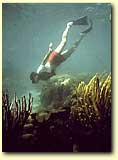 There aren't many cooler vacation spots in America than Miami Beach. Fashion
models, rock stars, actors, and filmmakers, along with ordinary people from all
over the world, visit this small island in Miami's Biscayne Bay. They
enjoy the sun and the great weather and the beautiful white sand, shop in the
exclusive boutiques, and party all night in hip nightclubs and discos.
There aren't many cooler vacation spots in America than Miami Beach. Fashion
models, rock stars, actors, and filmmakers, along with ordinary people from all
over the world, visit this small island in Miami's Biscayne Bay. They
enjoy the sun and the great weather and the beautiful white sand, shop in the
exclusive boutiques, and party all night in hip nightclubs and discos.
Miami Beach is home to the Latin America headquarters of Sony Music, MTV, and
Nickelodeon. It's also home to a rich mix of cultures. Almost half of its
population of 90,000 is Latino. Large numbers of African Americans
and Jews also call Miami Beach home. It's one of America's most culturally
diverse cities, a place where the action never stops.
It's hard to believe that in 1912, Miami Beach didn't exist at all. Back then,
Miami had a population of only about 12,000. A half-finished wooden bridge led
from the city toward a small, swampy island in Biscayne Bay. John Collins, who
owned part of the island, had hoped to grow avocado trees on the island, and
sell some of its land for oceanfront homes. But he ran out of money before a
bridge to the island could be finished.
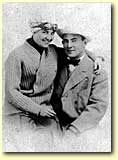 That same year, Carl Fisher, a wealthy businessman from Indianapolis Indiana,
came to Miami to vacation with his wife, Jane. And when Fisher saw the
half-finished bridge and the island beyond it, he came up with an idea that
would change Miami forever.
That same year, Carl Fisher, a wealthy businessman from Indianapolis Indiana,
came to Miami to vacation with his wife, Jane. And when Fisher saw the
half-finished bridge and the island beyond it, he came up with an idea that
would change Miami forever.
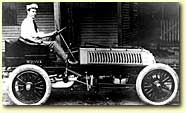 Fisher, who was then in his early forties, had made a fortune selling
everything from bicycles to automobiles. He was a race car driver who once held
the world speed record. He had built the Indianapolis Motor Speedway and
founded the Indy 500. And he had recently sold his automobile headlight company
for 6 million dollars. Fisher would use that money--and ten years of hard
work--to turn a swampy island into a vacation paradise.
Fisher, who was then in his early forties, had made a fortune selling
everything from bicycles to automobiles. He was a race car driver who once held
the world speed record. He had built the Indianapolis Motor Speedway and
founded the Indy 500. And he had recently sold his automobile headlight company
for 6 million dollars. Fisher would use that money--and ten years of hard
work--to turn a swampy island into a vacation paradise.
Fisher brought in a crew of workers to clear the trees from the island, build a
rock wall around it, and fill in the land with sand. Then the crew brought in
loads of rich topsoil. They spread it over the beach, then planted tropical
palm trees and other exotic plants.
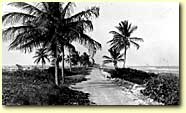 Carl Fisher's money kept flowing, and Miami Beach continued to grow. His crews
built roads and sewers. They installed electric wires. They built golf courses,
tennis courts, and yacht clubs. Fisher brought rich Northerners down to survey his paradise, and tried to sell
them some land. But they saw Miami as a remote outpost. They refused to buy.
Carl Fisher's money kept flowing, and Miami Beach continued to grow. His crews
built roads and sewers. They installed electric wires. They built golf courses,
tennis courts, and yacht clubs. Fisher brought rich Northerners down to survey his paradise, and tried to sell
them some land. But they saw Miami as a remote outpost. They refused to buy.
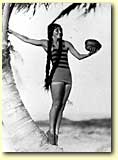 That's when Carl Fisher's genius for promotion saved the day. He found a
trained elephant--an unusual attraction in those days--and had it photographed
on the beach. He hired beautiful young women, outfitted them in skimpy bathing
suits, and photographed them as well. Then he sent the photographs, along with
stories about Miami Beach, to newspapers across the country.
That's when Carl Fisher's genius for promotion saved the day. He found a
trained elephant--an unusual attraction in those days--and had it photographed
on the beach. He hired beautiful young women, outfitted them in skimpy bathing
suits, and photographed them as well. Then he sent the photographs, along with
stories about Miami Beach, to newspapers across the country.
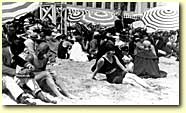 These publicity stunts did the trick. Within a few years, Miami Beach was the
hottest vacation spot in America. People flocked to the beach from all over the
East and Midwest. They built magnificent summer houses, held extravagant formal
socials, and swam in the refreshing waters of the bay. Carl Fisher's paradise
was complete. But soon forces even more powerful than Fisher himself would
destroy it all.
These publicity stunts did the trick. Within a few years, Miami Beach was the
hottest vacation spot in America. People flocked to the beach from all over the
East and Midwest. They built magnificent summer houses, held extravagant formal
socials, and swam in the refreshing waters of the bay. Carl Fisher's paradise
was complete. But soon forces even more powerful than Fisher himself would
destroy it all.
One of the most devastating hurricanes in American history swept down on Miami
Beach in 1926. More than 100 people died, countless buildings were ruined, and
the city itself was buried under 3 feet of sand.
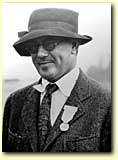 Fisher did all he could to repair the damage, but by then he was deeply in
debt. He had tried to repeat the success of Miami Beach on Mountauk Point, Long
Island, but the project strained his finances. In 1929, the stock market
crashed, and Fisher was finished. He died in Miami Beach in 1939, alone. His
fortune was almost gone. Fisher did all he could to repair the damage, but by then he was deeply in
debt. He had tried to repeat the success of Miami Beach on Mountauk Point, Long
Island, but the project strained his finances. In 1929, the stock market
crashed, and Fisher was finished. He died in Miami Beach in 1939, alone. His
fortune was almost gone.
Unlike Carl Fisher, Miami Beach recovered. From the 1930's to the 1950's,
businesspeople built new hotels and highrise condominiums on the beach. Once
again, the tourists arrived to dine in posh restaurants, watch nightclub shows
featuring stars such as Frank Sinatra and Jackie Gleason, and shop in the
boutiques on Lincoln Road. Older Americans, many of them Jewish, came to Miami
Beach to retire.
The boom continued until the 1960's, when Miami Beach once again fell on hard
times. By the early 1980's, its residents were struggling to keep their
neighborhoods clear of drugs and crime. But the old hotels in the South Beach
area helped Miami beach to rise once again.
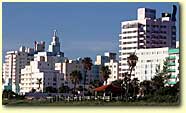 Activists from the Miami Design Preservation League began to restore the
hotels, which had been built in a colorful modern style known as Art Deco.
Fashion photographers discovered the restored hotels and used them as the
site of photo shoots. More and more young people were drawn to the
beach--especially after it became a centerpiece of the TV show "Miami Vice."
Soon, Miami Beach had a new life, as an international paradise for a whole new
generation. Activists from the Miami Design Preservation League began to restore the
hotels, which had been built in a colorful modern style known as Art Deco.
Fashion photographers discovered the restored hotels and used them as the
site of photo shoots. More and more young people were drawn to the
beach--especially after it became a centerpiece of the TV show "Miami Vice."
Soon, Miami Beach had a new life, as an international paradise for a whole new
generation.
If you're visiting Miami Beach--or any other cool vacation spot--this summer,
WayBack can help you share your experience. You can send a free email
postcard and tell your friends and family all about your summer vacation
adventures.
|
|

